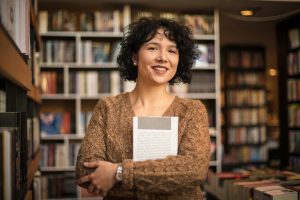By: Rachel Maraoi, M.A.T.
What happens when students stop turning in their work — not because they’re disinterested, but because the course wasn’t built with them in mind?
That’s the question I found myself asking in my English 101 classroom. Originally, I taught English 101 with traditional instructional strategies, including lectures, readings, and essays. But it wasn’t working. Students were disengaged, and some didn’t turn in their work. I started asking myself, “What’s getting in their way?”
That’s when Universal Design for Learning (UDL) provided me with an answer.
Part 1: Identifying the barriers

The most significant barrier I noticed was my students’ confidence.
Many of my students are first-generation college students or returning adult learners. They often arrive believing they aren’t “good writers.” The traditional format didn’t leave much room to build skills gradually or reflect on growth.
Accessibility was another issue. Not everyone learns well from text-heavy assignments, and some students struggled with attention, organization, or anxiety about participation.
Part 2: Analyzing the learning environment

After assessing the learning barriers in English 101, I examined my course materials and activities.
I realized that while I provided instructions and deadlines, I wasn’t offering many ways to engage with the material. There weren’t enough scaffolding or opportunities to engage in low-stakes ways. The classroom felt like it was built for students who already knew what they were doing, not for students who were still figuring it out.
Part 3: Designing +1 UDL Solutions

To address this barrier, I’ve incorporated a variety of UDL-friendly activities into my instruction. For example, I introduced visual discussion boards where students post images to represent their essay topics, allowing them to express ideas visually before putting them into words. I also redesigned writing assignments with scaffolded steps — such as low-stakes peer reviews and Zoom check-ins — so students can gradually build confidence over time.
I offered choices wherever I could. Students could summarize their sources in writing or by creating a short voice memo. For reflections, they could write a journal entry, record a video, or even make a visual mind map. By offering multiple means of engagement and expression, students could work with their strengths while still meeting learning goals.
Part 4: Reflecting on the impact

With these +1 UDL Solutions implemented, I believe learner engagement will increase. I hope my students will feel more comfortable posting and commenting on discussion boards. Their writing should improve because they will feel more connected to their topics and more confident in the process.
Bringing UDL into my English 101 class is not about making the coursework easier; it is about making learning more possible. More human. More inclusive.
I’m excited to continue building on this work, and I hope my story encourages other instructors to experiment with small changes that make big impacts.
About Professor Rachel Maraio
Rachel Maraio is an associate professor of English and the English 100/101 coordinator at Goodwin University. She earned her Master of Arts in Teaching (M.A.T.) from Quinnipiac University. Rachel primarily teaches first-year composition, though she also enjoys teaching literature. She lives in Connecticut with her family and their rescue dog.
Ready to get started? Learn more about beginning your Goodwin journey today!
Goodwin University is a nonprofit institution of higher education and is accredited by the New England Commission of Higher Education (NECHE), formerly known as the New England Association of Schools and Colleges (NEASC). Goodwin University was founded in 1999, with the goal of serving a diverse student population with career-focused degree programs that lead to strong employment outcomes.

